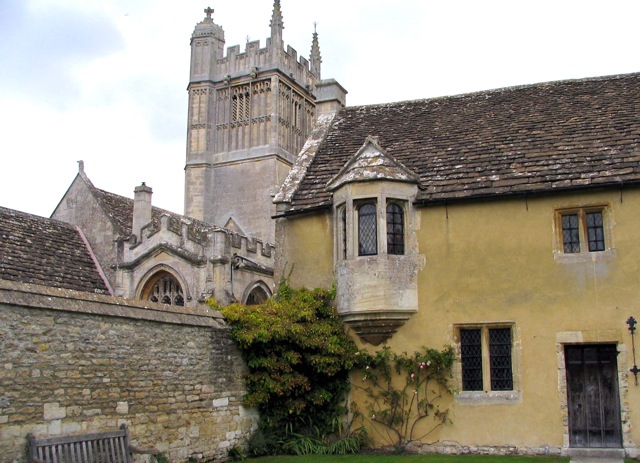.
Explore Westwood
Bradford on Avon, Wiltshire
.
.
St Mary, Westwood from the Manor House
St Mary’s Church was first mentioned in 1299, as a chapel of Bradford, but most of it is in the perpendicular style, of the late 15th century. Notable is the west tower with panelled upper stage that is related to those at Yatton Keynell, Nettleton and Devizes St James. It was paid for by the clothier Thomas Horton (died 1530). The chancel is earlier and plainer than the tower and nave, with a 13th century doorway. A famous feature inside is the Westwood “Imp” or “Devil” or “Lad”, a winged figure carved into the corbel that supports the tower stair turret.
.
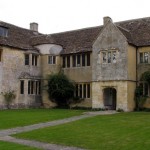 Next to the church is Westwood Manor House. It was begun in about 1400, enlarged c1480 for Thomas Culverhouse, again about 1515-1530 for Thomas Horton and 1616-1642 for John Farewell. The latter had a floor inserted to divide the open Great Hall and provide a Great Chamber and Parlour upstairs. He also added the King’s Room. The gardens are divided up by tall hedges and there is a 15th century barn across a yard.
Next to the church is Westwood Manor House. It was begun in about 1400, enlarged c1480 for Thomas Culverhouse, again about 1515-1530 for Thomas Horton and 1616-1642 for John Farewell. The latter had a floor inserted to divide the open Great Hall and provide a Great Chamber and Parlour upstairs. He also added the King’s Room. The gardens are divided up by tall hedges and there is a 15th century barn across a yard.
The house belongs to the National Trust and is open to the public.
.
 Lower Westwood Baptist Chapel was built in 1865 with the backing of the Back Street Baptist Chapel in Trowbridge and the builder was Moody of Trowbridge. A schoolroom was added in 1882, again with assistance from Trowbridge baptists. By the time of the second World War, the chapel was out of use and had been put to other uses- the schoolroom was used for the infants of the village school until the present Westwood-with-Iford Primary School opened in 1976. The chapel was sold in 1978 and is now a house.
Lower Westwood Baptist Chapel was built in 1865 with the backing of the Back Street Baptist Chapel in Trowbridge and the builder was Moody of Trowbridge. A schoolroom was added in 1882, again with assistance from Trowbridge baptists. By the time of the second World War, the chapel was out of use and had been put to other uses- the schoolroom was used for the infants of the village school until the present Westwood-with-Iford Primary School opened in 1976. The chapel was sold in 1978 and is now a house.
.
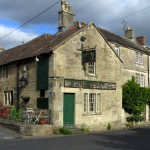 The New Inn was listed in the Ale Housekeepers’ Register 1822–7 and a deceased victualler, Thomas Swansbury, was mentioned in 1799, so is not really very new! The building seems to be of seventeenth century date and faces on to an old track from Bradford which is now a footpath. An extension that is probably of the late 18th or early 19th century was built on the southern end, with its gable to the turnpike road, where the tollgate was sited.
The New Inn was listed in the Ale Housekeepers’ Register 1822–7 and a deceased victualler, Thomas Swansbury, was mentioned in 1799, so is not really very new! The building seems to be of seventeenth century date and faces on to an old track from Bradford which is now a footpath. An extension that is probably of the late 18th or early 19th century was built on the southern end, with its gable to the turnpike road, where the tollgate was sited.
.
.
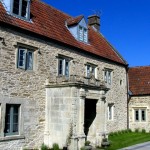 Upper Farm, in Upper Westwood, has a five-bay 17th century house of rubble stone with mullioned windows. It has a later ashlar porch with battlements and fluted pilaster columns. It was once called Shute’s Farm and was part of the Manor of Iford. The farm ceased working some years ago and the buildings around the yard have been converted into housing and the farmhouse has been restored.
Upper Farm, in Upper Westwood, has a five-bay 17th century house of rubble stone with mullioned windows. It has a later ashlar porch with battlements and fluted pilaster columns. It was once called Shute’s Farm and was part of the Manor of Iford. The farm ceased working some years ago and the buildings around the yard have been converted into housing and the farmhouse has been restored.
.
.
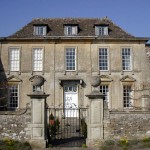 Further along Upper Westwood is Greenhill House, once called Well House, an early Georgian mansion, built of ashlar stone in a baroque style. It has five bays and two storeys with dormers in its hipped stone-covered roof. Gabled wings on each side are in 17th century style, but built later. A garden of long flower borders is on the other side of the road.
Further along Upper Westwood is Greenhill House, once called Well House, an early Georgian mansion, built of ashlar stone in a baroque style. It has five bays and two storeys with dormers in its hipped stone-covered roof. Gabled wings on each side are in 17th century style, but built later. A garden of long flower borders is on the other side of the road.
.
.
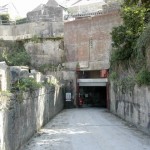 Beyond Greenhill a lane drops to the entrance of Westwood Quarry. The underground stone quarries, which are still worked on a small scale, were used for growing mushrooms and, during World War 2, part was converted into a factory for the Royal Enfield Company and another part for storing objects from the British Museum and other museums and art galleries.
Beyond Greenhill a lane drops to the entrance of Westwood Quarry. The underground stone quarries, which are still worked on a small scale, were used for growing mushrooms and, during World War 2, part was converted into a factory for the Royal Enfield Company and another part for storing objects from the British Museum and other museums and art galleries.


